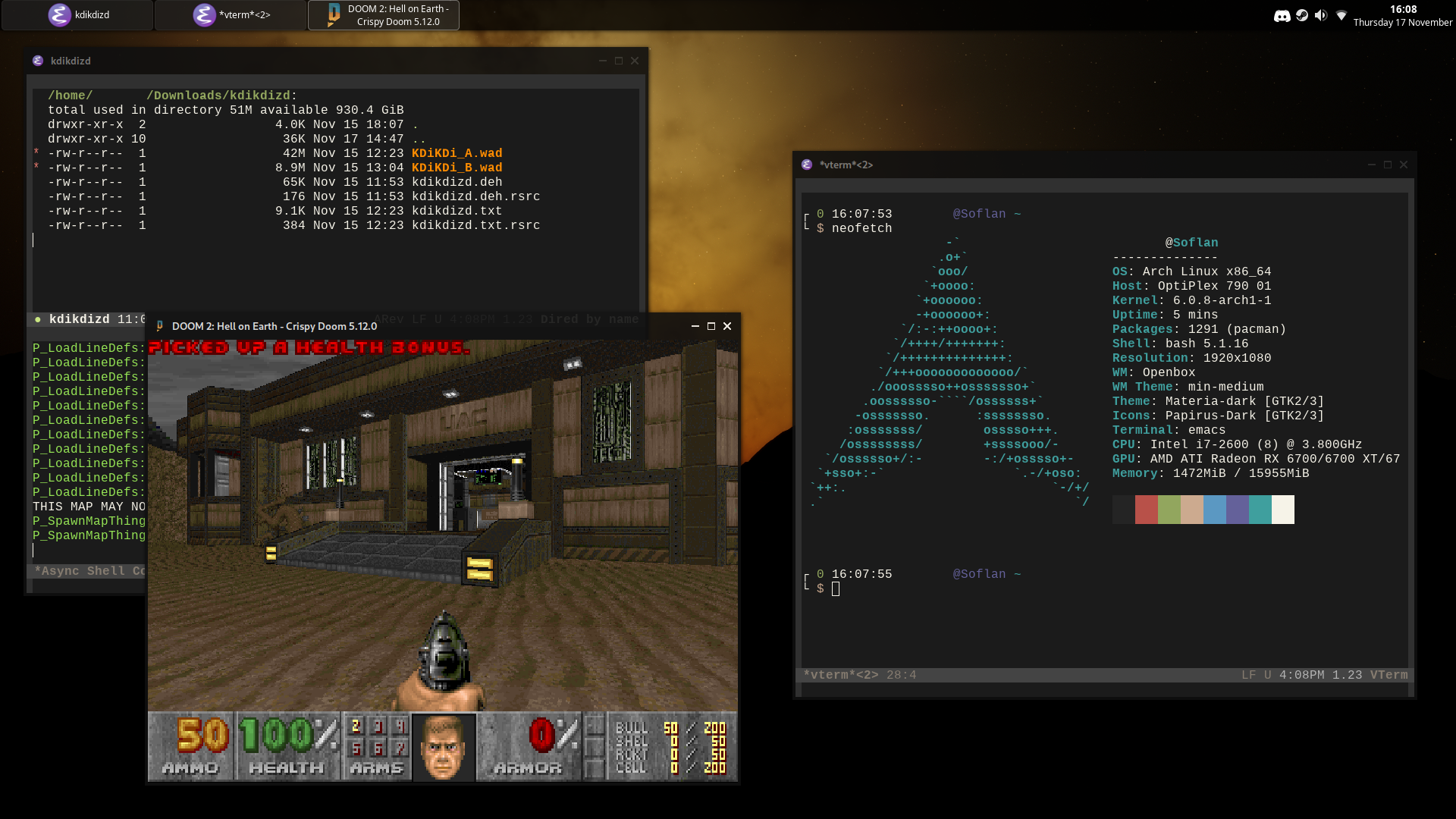- 24 Posts
- 22 Comments
I don’t think that’s a good idea. Pretty much all interaction with Emacs is mediated through keybinds. There is no distinction between shortcuts and fundamental behavior. Even ordinary typing is done by having each character on your keyboard bound to
self-insert-command. Perhaps there is some way to nuke the global keymap, but then you’re left with literally nothing. Besides, this would not prevent various modes from adding their own keys anyway.You should consider whether Emacs keybinds are actually in the way enough to be bothersome. You can also
keymap-global-unset(orkeymap-unset) individual bindings that you find problematic. I’d also consider delving into the Spacemacs code to see how they implement their “vi only mode.”
Emacs’s regular clipboard is the “kill ring” which also allows you to retrieve any previously cut/copied text. It also has “registers” where you can store and retrieve snippets of text, which can be considered clipboards when used for this purpose. Registers can be referenced by any character you can type on your keyboard, including control characters like ^D.
This totals… a lot of clipboards.
My heart sank upon reading the word “electron” and rose again on the very next paragraph. I’m looking forward to seeing it in action.
I think that this is above all else the reason that I use Arch. Arch Linux makes creating packages trivial, basically just wrapping build instructions into a shell script template. Arch handles the rest. The build systems for deb or rpm packages don’t come close, and good luck rolling your own flatpak.
This allows me to use pacman for everything outside of my home directory. Pacman is practically the central feature of my computer, and it’s wonderful. I’m sure those Nix people can relate, though I guess my method is a bit less robust.

 5·10 months ago
5·10 months agoXremap, despite the name, supports both X and Wayland, and can be used to move modifier keys around. Configuration is done with YAML but is otherwise pretty easy. I personally use it for full Emacs keybind emulation.

 1793·10 months ago
1793·10 months agoThis might be the first time I’ve ever seen something productive happen in the Phoronix forums. I love that place. Go to any topic with more than about a dozen posts and it’s almost guaranteed to be a flame war. Genuinely one of the funniest places on the Internet.
Check out this one. It took like three posts!
I have done almost the opposite: moving as much configuration as I can into use-package statements, even for built-in features like dired. You can
(use-package feature-name)or even(use-package emacs)in order to customize the basics. use-package just provides much better organization than any schema that I have ever been able to come up with on my own.

 24·1 year ago
24·1 year agor/cth was originally a subreddit for the podcast Chapo Trap House, but it eventually bloomed into a general-purpose leftist space. IIRC, the sub was around 160k members at its peak and had a distinct posting culture.
It was quarantined by Reddit for violent speech after calling for the death of slave owners and later banned for no particular reason at the same time as r/the_donald, presumably as a “both sides” sort of thing.

 211·1 year ago
211·1 year agoHexbear is an instance formed mostly by former r/chapotraphouse users after that sub was banned from Reddit a few years ago. Hexbear used to run on a custom fork of Lemmy so that the community could add extra features that they wanted (like custom emoji) but it was recently ported back to mainline Lemmy after merging or reimplementing as many changes as possible.
Currently, Hexbear does not have federation enabled, and there is discussion about who to federate with or even whether to federate at all. The community is very active and self-sufficient and some members prefer the isolation.
Content-wise, it’s a leftist-focused instance. Some shitposts, some serious posts, and a lot of inside jokes.
I am a proud Openbox user. In the stacking realm, there is nothing quite like Openbox’s customizeability and the great tooling that surrounds it. In particular, opensnap gives me window snapping to the edge of the screen with the mouse, which is sorely missing from most light window managers. Openbox also has really powerful hotkeys (any arbitrary sequence of actions) alongside Emacs-style key chords, which makes it difficult to port my setup to any other environment.
One day, I hope to migrate to labwc, which seems to be carrying Openbox’s banner into the Wayland era. Unfortunately, labwc doesn’t (and probably never will) support key chords and I have not been able to find a suitable replacement for tint2, which I use as my taskbar. Someday…
Here is an old screenshot of mine. Nothing has changed since then.

bspwm is probably my favorite general-purpose tiling window manager. I have not personally tried this out yet, but River is superficially similar, with the main configuration done through a combination of shell scripting and
riverctlcommands. I’m not sure how the tiling behaves in comparison though.
This is something that I am sure will be solved eventually, but one of the major weaknesses of Wayland is the lack of lightweight standalone compositors.
For example, if I want a lightweight stacking window manager on X, I can choose between Openbox, Fluxbox, FVWM, IceWM, Pekwm, JWM, Window Maker, hell even twm if I were a masochist. I have tried out all of these at one point or another and they all have something to offer users. But using Wayland, there’s, uhh, labwc, and that’s it? Maybe I could try using kwin standalone?
The situation for tiling window managers is similar, with Sway being the only one that feels mature.
I plan on migrating from Openbox to labwc at some point in the future, once it’s ready. labwc itself is really good, but some of the other programs I need to recreate my setup aren’t there yet. Someday…

 6·1 year ago
6·1 year agolemmit.online is an instance where a bot reposts Reddit content.
I think an underappreciated thing about the original LEGO Star Wars games is just how accessible they were. You could give those games to a 5 year old and they could play and enjoy it. I should know; I was one of them. Looking at the Skywalker Saga, you couldn’t possibly do the same thing.
Yeah, those were the days. Hexbear carries some of the culture, but is generally a nicer place to be.
Old account here. I was directed to Hexbear after r/cth was banned from Reddit. Later on, I learned about other instances. Federation wasn’t a thing back then; I made an account here to check federation out once it finally released.
Lemmygrad is a Marxism-focused instance and Hexbear is currently making the migration to mainline Lemmy right now.

 1·1 year ago
1·1 year agoLemmygrad is a marxist-focused instance and Hexbear is currently making the migration to mainline Lemmy right now.


















The reason that Doom is so portable goes beyond Linux and is an artefact of its development. id developed Doom on NeXTSTEP (i.e. Unix) machines and obviously targeted DOS. This is pretty unique among DOS games at the time and required id to write as much code as possible in a platform agnostic way. This means that the main engine does not care about where it is running and the usual DOS hacks are contained to DOS-specific files. In order to port Doom to a new platform, ideally one only needs to rewrite the system-specific implementation files for video, sound, filesystem access, etc., and this mostly holds true today. (These files are prefixed with
i_in the Doom source).The Linux port is just one of many versions developed at the time. I don’t believe that it was commercially released; it was more of a portability test. The reason that the Linux version was chosen for the source release over the DOS version was because it didn’t rely on the proprietary DMX sound library that the DOS port used.